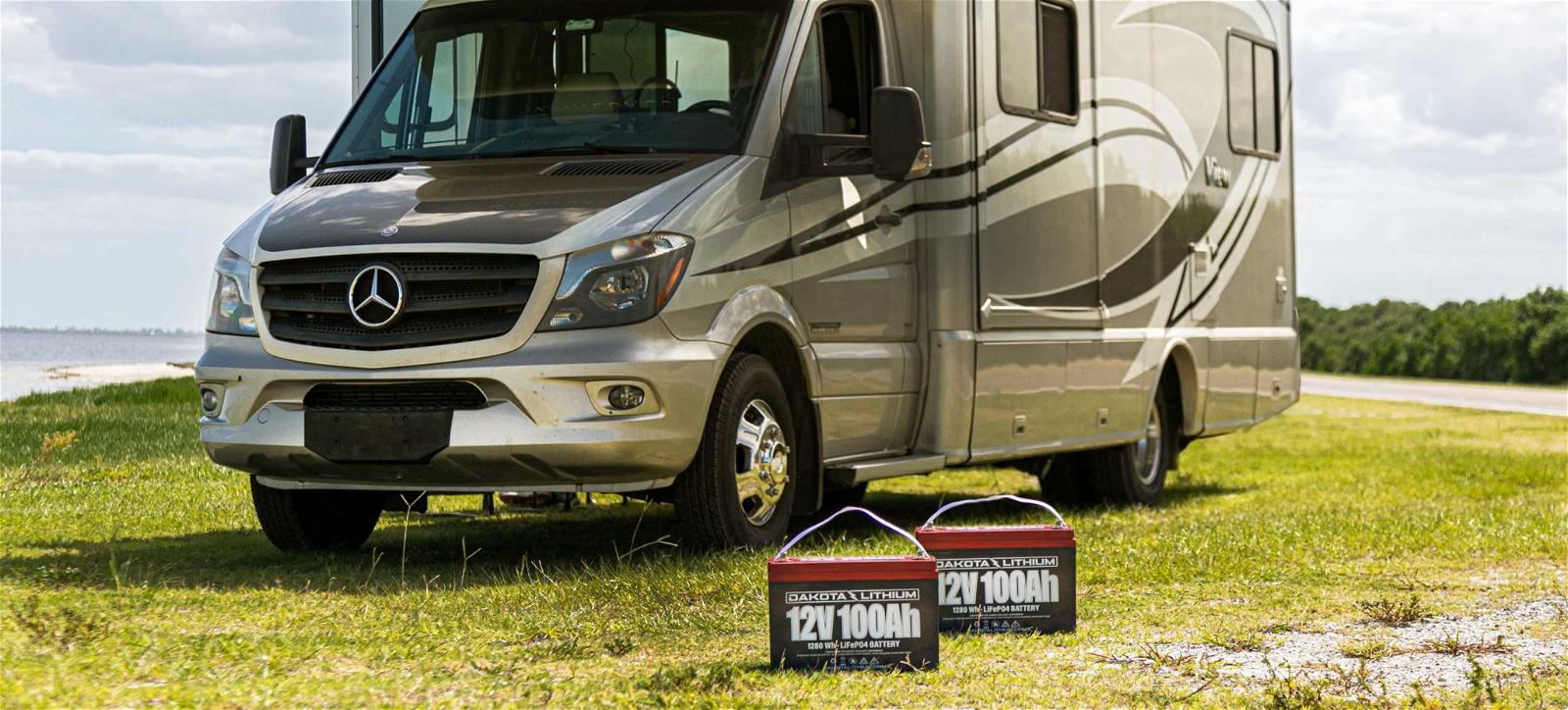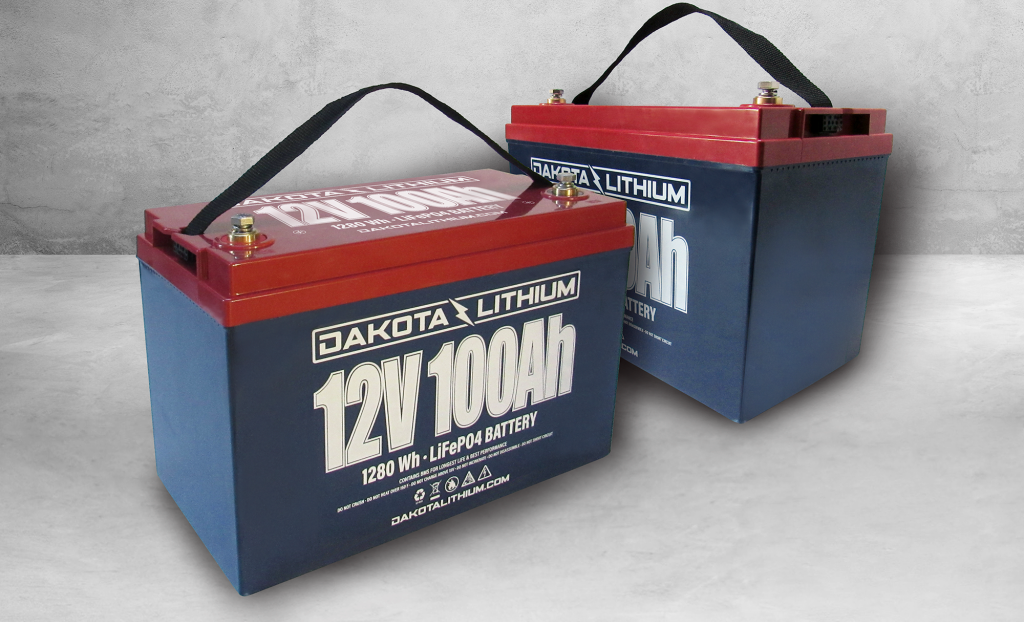How to Upgrade Your RV’s Electrical System For Lithium Batteries
December 14, 2020 | Andrew Jay
 Dakota Lithium batteries are a drop in replacement for AGM, SLA, or traditional lead acid batteries. The most common size battery for RVs is the group 27 size 100Ah battery and the Dakota Lithium 100Ah battery is a drop in replacement — meaning it is the same size and dimensions as the RV house battery it is replacing. But with significantly more performance (more on this below).
Dakota Lithium batteries are a drop in replacement for AGM, SLA, or traditional lead acid batteries. The most common size battery for RVs is the group 27 size 100Ah battery and the Dakota Lithium 100Ah battery is a drop in replacement — meaning it is the same size and dimensions as the RV house battery it is replacing. But with significantly more performance (more on this below).
But does “drop in replacement” mean you can just plug and play and call it good?
No. Although you can simply drop the batteries in to your RV and enjoy increased performance, you may not get your Dakota Lithium’s full capabilities without additional changes to your RV, van, or trucks’ electrical system. Here’s the changes we recommend to get the most out of your Dakota Lithium RV house battery upgrade:
- Charge your batteries with a lithium specific charger, or change your charging voltage to 14.4 volts (also called the lithium setting on dual purpose chargers). Dakota Lithium batteries are built with lithium iron phosphate technology. Our R&D testing has found that a charging voltage of 14.4 volts provides the greatest performance for lithium iron phosphate batteries. Lead Acid, AGM and SLA chargers will charge the batteries safely, but not fully. Lead acid chargers charge at a lower voltage and stop when the battery reaches the “I’m full” voltage associated with lead acid batteries. Since that voltage is lower than when a lithium battery is full, your Dakota Lithium will only have a 80-90% charge, meaning an upgrade to a lithium charger will unlock more power. All Dakota Lithium 100Ah batteries come with a 12V 10 Amp lithium specific charger included free of charge. See the rest of our charging options here. For larger RV, Skoolie, or trailer builds, or off grid cabins, you may want to consider the Victron MultiPlus C 12/2000/80-50 120V Inverter & Charger, which is a lithium specific charger, battery monitor, and DC to AC inverter (turns battery power into wall sockets for household electronics) combined into one blue box.
- If charging your house batteries from your engine’s alternator we recommend a Victron Orion-Tr Smart 12/12-18A Isolated DC-DC charger. This will charge your batteries at a lithium specific setting using the electricity created by your engine’s alternator. It will also protect your engine’s alternator from the wear and tear of charging lithium batteries (which charge faster than lead acid). Plus, it includes a smart battery monitor, so you can use the Victron app to see how much power is left in your batteries, and how much you are currently charging them. This feature makes this charger a favorite upgrade of van builds, skoolies, overland truck builds, and small RVs where you plan to spend more time boondocking and camping off-grid and want a simple way to monitor your batteries.
- If using solar panels to charge your batteries, then change your solar controller setting to lithium or upgrade to a lithium specific solar controller. Dakota Lithium batteries are optimized for solar energy. Lithium Iron Phosphate has the best transfer efficiency of all the battery chemistries, meaning that you can use more of the energy produced by your solar panels. To get the most out of any solar system using lithium batteries you will need a solar charge controller that has a lithium setting like this Victron SmartSolar MPPT 75/15 Solar Charge Controller.
Some key things to remember. All Dakota Lithium 100Ah batteries include a free lithium specific charger, so if you are charging your house batteries only off shore power then you can simply use an extension cord to the included charger and no changes are needed. Also, more of the battery chargers and solar controllers coming onto the market these days are dual purpose, with a lead acid and a lithium setting. So if you have a lithium setting use it.
So knowing the changes needed is a lithium battery upgrade still worth it?
Most definitely yes!!
Here’s 8 Reason’s Why a Dakota Lithium Upgrade Provides the Greatest Lifetime Value
- Dakota Lithium LiFePO4 batteries will provide double the usable power / double the run time of lead acid. More power / run time means more time on the road without having to plug in at night. Allows for boondocking or camping off grid with the confidence that your batteries will get your through the night (or with solar panels near indefinitely).
- Dakota Lithium batteries last 4X longer than lead acid or AGM and will need to be replaced less often. Providing piece of mind and greater lifetime value. Backed up by a best in class 11 year warranty.
- Dakota Lithium weighs 60% less than deep cycle lead acid batteries. Less weight means more maneuverability and speed and less wear and tear on your rig. And the batteries are light enough that you can easily install and service them yourself.
- Dakota’s lithium iron phosphate works down to negative 20 degrees Fahrenheit (-29 Celsius) meaning you can travel in all seasons.
- The self discharge rate of a Dakota Lithium battery (i.e. how much power is lost each month the battery is not being used), is 1/4 that of a lead acid battery, only 1-2% a month. That means if you take a break between adventures your batteries will still have plenty of power the next time you hit the road.
- Dakota Lithium iron phosphate is optimized for solar energy with 50% more efficiency than a lead acid battery.
- You need less batteries when you use a Dakota Lithium. Lithium iron phosphate (LiFePO4) has a flat voltage curve. That means that the voltage does not drop as you use the battery. You get all the juice down to the last drop. Historically if you power your house electronics with a deep cycle lead acid battery you would only be able to use half of the capacity of the battery before the voltage is too low to run anything. That’s why your lights dim when your lead batteries are low. With Dakota Lithium you can use all of the power of the battery, meaning that a 100 Ah battery from Dakota Lithium is equal to 200 Ah in lead acid batteries.
- Dakota Lithium has an 11 year warranty. That means you can install your batteries once, instead of replacing heavy lead acid batteries every few years.
What Size Battery Do I Need?
The drop in replacement battery for most RV house batteries (deep cycle marine) is the Dakota Lithium 100Ah battery [See specs and buy here].
Here’s a simple guide to battery recommendations. These recommendations assume you are either re-charging your battery bank every few days by connecting to shore power, or charging via your alternator in your engine when you drive, or with solar panels (our personal favorite – with the low cost of adding solar panels it is both the most affordable, and the highest performance charging solution).
Size of RV / Van | What Your Looking to Power | Recommended Battery
- 10′-14 ft | Lights, radio, electronics (laptop, cell phones, etc.), small fan | DL 54 Ah x 1
- 10′-14 ft | Lights, radio, sm. electric cooler, tools, fans, electronics | DL 100 Ah x 1
- 15′-20 ft | Lights, radio, stove, med. electric cooler/small fridge, electronics, fans | 1-2x DL 100 Ah or 1x DL 320 Ah
- 21′-30 ft | Lights, radio, stove, lg. electric cooler/small fridge, small tv, electronics, fans| 2x DL 100 Ah or 1x DL 320 Ah
- 31′-40 ft | Lights, radio, stove, medium fridge, large TV, electronics, large fans | 2-4x DL 100 Ah or 2x DL 320 Ah
- 40’+ ft | Lights, radio, stove & oven, fridge, TV, electronics, air conditioning* | 4-8x DL 100 Ah or 2-5x DL 320 Ah
*Please note, air conditioning appliances draws a lot of amps (power) and requires a very large battery bank (400Ah+). Not recommended for small RVs or vans. Use of air conditioners is not covered under the warranty of many battery companies, including Dakota Lithium, since it is possible for air conditioning units to pull more power at one time than a single battery is capable of giving. Air conditioning is fine to use when connected to shore power and not pulling power from the house batteries.

The Dakota Lithium 100Ah battery is the drop in replacement battery for most RV house batteries (deep cycle marine)
What Size Solar Panels Do I Need?
Dakota Lithium batteries are the best choice if you are considering adding solar panels to your RV, Van, or trailer because they have the highest efficiency rating for solar power. That means you get more power from each solar panel, and can use more of the power you collect. A deep dive on solar power efficiency is here.
Here’s a size chart for what solar panels you need by size of RV & how many Dakota Lithium batteries you have.
Size of RV | # of Batteries | Recommended Solar Panel Capacity
- 10′-14′ | 1-2x DL 100 Ah | 100-115-Watt Rooftop
- 15′-20′ | 1-2x DL 100 Ah | 150-170-Watt Rooftop
- 21′-30′ | 2x DL 100 Ah | 300 watt rooftop
- 31′-40′ | 2-4x DL 100 Ah | 500-600 watt rooftop
- 40’+ | 4-8x DL 100 Ah | 700-1100 watt rooftop
What size solar panel and battery do I need for my RV air conditioner?
Air conditioners are power hungry appliances. If you are running air conditioning in your RV, van, or camper then and you will need a larger solar panel and battery system. To meet the high energy needs of an air conditioner many nomads use a generator to power their air conditioner when off grid or RV camping. The problem, however, is generators run out of gas, are loud, the gas is expensive and you need to carry extra gas cans, and the exhaust is toxic and dangerous if not well ventilated (if using a generator make sure to install a carbon monoxide detector in your living space). To unshackle from shore power and the need to run a generator RV owners and nomads living the #VanLife are increasingly choosing to install solar panels and batteries that are large enough to power an air conditioner without the noise, smell, or health risk of a generators. The result is greater freedom to camp and boondock anywhere, increased health and safety, and more time in your day. You do some work to install the system once and then its maintenance free. No need to buy gas and refill the generator gas tank each day. No need to start an engine. No need to apologize to the neighbors for running your generator all night. Just free power from the sun keeping you nice and cool at night.
Determine the size of the power system you need by the size of the space you are cooling and the size of the air conditioner needed. Air conditioner size is measured in BTUs.
Size of RV | BTUs of Air Conditioner | # of Batteries | Recommended Solar Panel Capacity | Recommended Off-Grid Power System
Learn More: